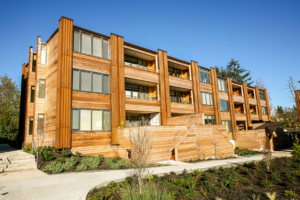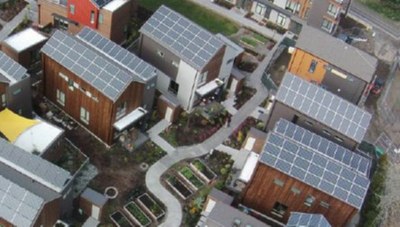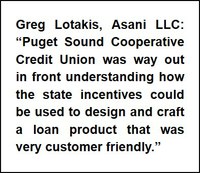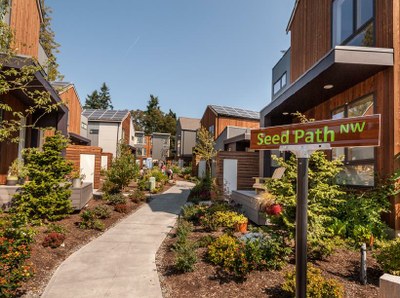Density Bonus for Solar-Powered Grow Community, Bainbridge, WA
Case Study: Published | Updated: | | Bainbridge Island, Washington |- Category
- category_listing(s)
- Building Type
- Multifamily
- Innovation
- Density Bonus for Certified Green Housing
- Jurisdiction
- Bainbridge Island, Washington
- Parcel
- Officials
- Heather Wright | City of Bainbridge Island
- Team
-
Heather Wright
|
approving-official
Greg Lotakis | developer
Shannon Ellis-Brock | Solar Energy Financing
Marja Preston | Public Meeting Facilitator
Tadashi Shiga | Verifier
- Ratings & Awards
- Built Green 5-star
One Planet Living Community
Built Green Hammer Award for Multi-Family (2015) and Single Family (2014)
NAHB Best In Green Award for 2014, honoring the very finest in sustainable design and construction.
Green Home of the Year Award in the Best Community Project category for 2014 by Green Builder magazine
Named as one of the ten best Urban Agriculture projects worldwide by Urban Land Magazine.

By participating in the HDDP program (see related Policy Profile), the project would not only undergo the normal land use permitting process which is costly and time consuming. They were also committing to meet a number of additional requirements, such as smaller home sizes, a diversity of housing types, and “deep green” performance goals tied energy, water, stormwater design targets. The HDDP incentive allowed this project to increase height and density, in exchange for committing to meet these goals.
The development was permitted in 2 phases, using a standard land use application review process applied to this housing type, with additional review steps including a conceptual proposal review to make an initial determination of eligibility for the HDDP incentive. Subsequent steps included a pre-application conference, public participation meetings, as well as ongoing assessment and corrections to maintain eligibility for the program incentives. This culminated in Design Review Board consideration, and a Hearings Examiner review, public hearing and approval granted with conditions.
| Code Requirement | Compliance Path |
|---|---|
| City of Bainbridge Island Housing Design Demonstration Program (HDDP) BIMC 2.16.020.Qrequires Built Green 5-star certification, innovative site design and diversity of housing types | Applicant provided a conceptual proposal, held public meetings, and underwent pre-application review, to gain City Council approval for HDDP standard modifications and density bonus via underlying land use application review. See Staff Report and Hearings Examiner Decision for more details |
 The homes are all highly insulated, air tight, and all-electric; most have solar power bringing some homes to “net zero energy” while others are within 10 to 20% of “net-zero energy” depending on occupant behavior (i.e. homes that produce all the energy they use). Systems within each home that contribute to this result – include all LED light fixtures, air-to-air electric heat pumps, heat pump hot water heaters, and heat recovery ventilation for whole house air exchange. The below grade parking in Phase 2 allowed more innovation in air‐to‐air heat pump technology with integrated water heating “plants” for each of the multi‐family buildings, increasing water heating efficiency by as much as 300%. The multi-family buildings’ energy performance is being studied through a grant-funded partnership with Bonneville Power Administration and EcoTope a mechanical engineering firm.
The homes are all highly insulated, air tight, and all-electric; most have solar power bringing some homes to “net zero energy” while others are within 10 to 20% of “net-zero energy” depending on occupant behavior (i.e. homes that produce all the energy they use). Systems within each home that contribute to this result – include all LED light fixtures, air-to-air electric heat pumps, heat pump hot water heaters, and heat recovery ventilation for whole house air exchange. The below grade parking in Phase 2 allowed more innovation in air‐to‐air heat pump technology with integrated water heating “plants” for each of the multi‐family buildings, increasing water heating efficiency by as much as 300%. The multi-family buildings’ energy performance is being studied through a grant-funded partnership with Bonneville Power Administration and EcoTope a mechanical engineering firm.
